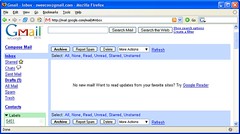Deprecated: Function create_function() is deprecated in
/home/metcomp/smm/wp-content/plugins/wp-spamshield/wp-spamshield.php on line
1858
 I don’t like to fight with anyone, especially not my readers but the more “productive” I become the less I understand the need for overflowing email in an inbox. In this article I’ll go through why email inboxes should be empty. I also take on the reasons people think it’s better to keep your inbox full and dispel them. I’m trying to be open minded so let me know your reasons for not keeping it empty.
I don’t like to fight with anyone, especially not my readers but the more “productive” I become the less I understand the need for overflowing email in an inbox. In this article I’ll go through why email inboxes should be empty. I also take on the reasons people think it’s better to keep your inbox full and dispel them. I’m trying to be open minded so let me know your reasons for not keeping it empty.
Reasons To Empty Your Inbox
Clear To-Do List
With an empty inbox all your tasks, follow ups etc are on your to-do list. There is no reason to look through last week’s messages to figure out what you need to do now.
Have Specific Information on Tasks
An email can be a long novel with tasks for you generously interspersed in it. When you create a task based on an email you get to write what you need to do in your own words. This way you see the task on your list as “Run Monthly Expense Report for February” and not “Re: FWD> RE: MC/GRF4 Return Test Files Available”
Nothing Gets Lost
With an empty inbox there’s no email from two days ago hiding 50 items below your visible screen with an important item to do.
Easy to see new urgent items
You have just new mail in your box so it’s easy to spot when something important comes in.
Clear Head
An empty inbox leads to clear thinking. You know exactly what you need to work on: process any new email that comes in and do your to-do list. Don’t underestimate the advantage of clear thinking. At a moment’s notice you know exactly what you need to do today and what you can see what you won’t be able to accomplish. This enables you to focus on what you need to do and not on all the emails around what you need to do.
Reasons Not To Empty Your Inbox
After reading about all the advantages to an empty inbox you’re wondering why would anyone not want to empty it. There are three reasons I hear most often, I’ll counter them below.
Easier to Find Email
Some people keep their email in their inbox to make it easier to find. Searching for an old email is a chore in Microsoft Outlook (and some other mail programs)- you need to go to locate the right folder and even then it’s very slow and limited. The solution is to download Windows Desktop or Google Desktop. These programs are both free and allow you to search your email or your entire computer fast. So store your email in whatever folder structure you want- or no folder structure- you can easily find it.
I Have a System
Many people say they have a system and that system involves keeping some email in the inbox. The problem I see is that with some to-dos hidden in emails in your growing inbox and some to-dos in other areas you may have conflicts and aren’t sure what to do next. So you start with the one staring at you now and miss an important one. The solution is to separate your to dos from your inbox. In Outlook you can use a program to turn your messages into tasks easily like Clear Context’s IMS. That’s the one I use and it’s improved my ability to process emails exponentially. It has extra buttons like “related messages” which works quickly at finding the email that your to do is about. It also includes special quick filing buttons. There much more it can do check out Clear Context.
It’s Too Hard To Empty My Inbox
Many people have hundreds or even thousands of messages in their inbox- to get through that many emails can be a major obstacle. The solution is to transition to an empty inbox and not just do it in one step/day.
1) Move your inbox to a new folder- Create a new folder let’s say it’s called inbox2. Move all messages from your inbox into inbox2. Maintain your old system (if you have one) on inbox2.
2) Start with a new inbox- From now on commit to emptying your inbox daily. Put items you need to work on in your to do list. In Outlook you can drag your message to the tasks icon to automatically create yourself a to do or you can use Clear Context IMS to do it easier.
3) Process your old inbox- Find chunks of your old inbox that you can file away. For example, if you’re subscribed to a list put all email from that list into a folder. Then you can put one to do item on your list- read that folder. You may decide you don’t want to read a certain list. Trash all those messages and unsubscribe. You may be able to get rid of another chunk by picking a date (say a month ago) and decide that you’ll move all those into an archive folder. Let’s face it if you haven’t done something about an email from a month ago you never will. If you need to reference it, you know where to find it. Similarly if you come across a long conversation that is no longer relevant sort by subject and move all those emails into your archives. Now sort by sender and get rid of batches of old emails. Continue your process trying to get rid of chunks of your old inbox. Hopefully by the time you’re done with the process your inbox2 folder will be tamed.
4) Maintain your old system- Keep doing what you used to so you don’t miss out on important tasks. Keep looking for opportunities to move tasks into your new system. Grab a bunch of inbox2 emails related to certain topic and file it in a folder and create an item on your to do list listing the next action on that project.
5) Finish the transition- When you get a good handle on inbox2 and there are just a few items left take the time to transition it to your new inbox and take appropriate action. Now destroy inbox2, you’re done- you have achieved an empty inbox.
6) Limit what comes in to your Inbox- One way to maintain an empty inbox is to limit what comes in to it. Be diligent about unsubscribing from lists that are no longer relevant. Create mail filters that file reference material or other mailing lists in their own folder so it doesn’t clutter what you need to do immediately. Schedule time to check those folders periodically.
This process can take time. Dedicate time each day to help the transition to an empty inbox. You’ll see once you experience an empty inbox you’ll feel free.
Merlin Mann has written an interesting set of articles helping people empty their inbox. He even has a presentation. 2Time contends that “Email Inboxes are a great indicator of professional productivity“. I’m not saying it’s the only indicator but it’s a good measure.
Does your inbox have items in it? Let me know why. Convince me. Are there more good reasons to have an empty inbox- let me know.
photo credit: Collin Anderson


